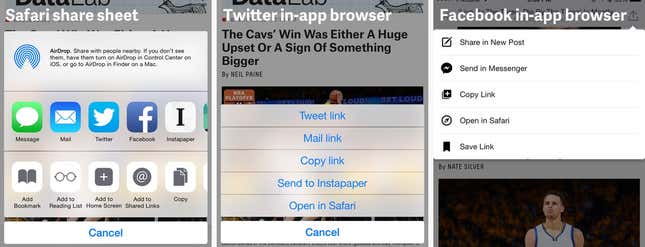Some of the most-used web browsers in the world aren’t really web browsers—they’re in-app browser windows, which pop up on your smartphone when you tap a link in your Facebook or Twitter feed, for example.
For years, these half-baked browsers have been cobbled together without much consistency. And they aren’t exactly great experiences. On the iPhone, for instance, because they’re separate from the main Safari browser, they don’t know if you’ve logged into a website—such as the New York Times subscriber paywall—and will ask you to log in again. When speed is crucial and typing is cumbersome, that just isn’t fun or helpful for anyone.
That may change in iOS 9, the new version of iOS that Apple unveiled this week at its Worldwide Developers Conference and will likely launch in September.
One of the iOS 9 features that Apple is discussing at the conference—but didn’t feature in its keynote—is called the Safari Services Framework. This new tool “can be used to display web content within your app,” Apple writes. “It shares cookies and other website data with Safari, and has many of Safari’s great features, such as Safari AutoFill and Safari Reader.”
It also includes Apple’s sharing button and extensions, which debuted last year with iOS 8, and lets developers add new ways to share content between apps. Today, neither Facebook nor Twitter supports Apple’s “share sheet” in its in-app browser window, opting for custom sharing menus, including an option to flee to Safari. Perhaps the aggregate of these improvements will encourage app developers to just embed Safari directly within their apps.

More broadly, it’s an interesting step in Apple’s ever-evolving tension between native apps and the web. Apple started the App Store revolution and has every incentive to keep pushing iPhone apps as the future of software. But in many situations, the web is still the right—or only—choice. (Facebook and Apple, meanwhile, are both experimenting with new forms of app-native publishing, and other features Apple has announced at WWDC blur the lines between apps and the web.)
This sort of compromise, where both apps and the mobile web get stronger at once—and work together more smoothly—is the best path forward for everyone.
